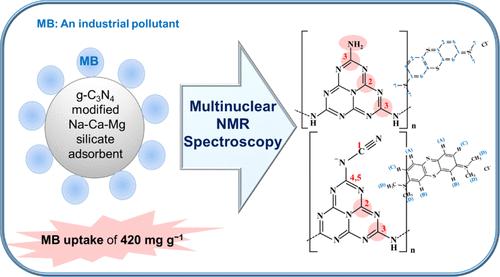当前位置:
X-MOL 学术
›
J. Phys. Chem. B
›
论文详情
Our official English website, www.x-mol.net, welcomes your
feedback! (Note: you will need to create a separate account there.)
Mechanistic Understanding of Superior Methylene Blue Adsorption Capacity in a Novel g-C3N4 Modified Amorphous Na–Ca–Mg Silicate Adsorbent: Insights from Multinuclear Solid-State NMR Spectroscopy
The Journal of Physical Chemistry B ( IF 2.8 ) Pub Date : 2024-12-09 , DOI: 10.1021/acs.jpcb.4c06514
Sezen Soyer-Uzun 1 , Ping Yu 2 , Feyza Kevser Öner 1 , Sabyasachi Sen 3
The Journal of Physical Chemistry B ( IF 2.8 ) Pub Date : 2024-12-09 , DOI: 10.1021/acs.jpcb.4c06514
Sezen Soyer-Uzun 1 , Ping Yu 2 , Feyza Kevser Öner 1 , Sabyasachi Sen 3
Affiliation

|
Silicate-based adsorbents offer significant advantages over traditional materials, particularly due to their superior thermal and chemical stability, enhanced regenerability, and the ability to endure more rigorous operating conditions. In this study, an amorphous Na–Ca–magnesium silicate adsorbent (SAAM) and its g-C3N4-modified counterpart (gCN-SAAM) were synthesized via alkali activation and a subsequent thermal process, respectively. The g-C3N4 modification resulted in a novel hybrid adsorbent with a remarkable methylene blue (MB) adsorption capacity of 420 mg g–1, four times higher than the unmodified sample, setting a new benchmark. Solid-state 29Si (MAS and CP/MAS), 1H MAS, and 13C CP/MAS NMR spectroscopy were used to investigate the complex structures of these adsorbents and their interactions with MB. The local structure of SAAM primarily consists of Q3 Si units, with minor Q0 and Q1 Si species, structural water, and Mg–OH sites. Exposure to MB caused an upfield shift in the 29Si CP/MAS spectrum and enhanced resonances in the high-field region, indicating MB interaction with Si sites. 1H MAS NMR spectra revealed significant interactions between water molecules in the geopolymer-like framework of SAAM and MB. The thermal treatment of SAAM with urea to produce gCN-SAAM enhanced the polymerization of Q3 Si species and increased the relative fraction of Q4 Si sites. This treatment also reduced the intensity of some Mg–OH units, showing interaction with g-C3N4. After MB adsorption on gCN-SAAM, NH2 groups of g-C3N4 disappeared, and shifts in the C2N-NHx and C3N sites indicated their involvement in adsorption, while Si sites remained intact. This thermal method creates a sustainable, cost-effective and efficient adsorbent for MB removal from wastewater. Multinuclear NMR spectroscopy provides detailed insights into the adsorbent’s complex structure and MB interactions, potentially guiding the design of improved future adsorbents.
中文翻译:

新型 g-C3N4 改性无定形 Na-Ca-Mg 硅酸盐吸附剂中亚甲蓝卓越吸附能力的机理理解:来自多核固体 NMR 波谱的见解
与传统材料相比,硅酸盐基吸附剂具有显著的优势,特别是由于其卓越的热稳定性和化学稳定性、增强的可再生性以及承受更恶劣操作条件的能力。在本研究中,通过碱活化和随后的热过程分别合成了无定形 Na-Ca-硅酸镁吸附剂 (SAAM) 及其 g-C3N4 改性对应物 (gCN-SAAM)。g-C3N4 改性产生了一种新型杂化吸附剂,其亚甲基蓝 (MB) 吸附能力显著,达到 420 mg g–1,是未改性样品的四倍,树立了新的基准。固体 29Si (MAS 和 CP/MAS)、1H MAS 和 13C CP/MAS NMR 波谱用于研究这些吸附剂的复杂结构及其与 MB 的相互作用。SAAM 的局部结构主要由 Q3 Si 单元、少量 Q0 和 Q1 Si 种类、结构水和 Mg-OH 位点组成。暴露于 MB 导致 29Si CP/MAS 光谱发生上场偏移,并增强高场区域的共振,表明 MB 与 Si 位点的相互作用。1H MAS NMR 波谱揭示了 SAAM 和 MB 的类似地质聚合物框架中水分子之间的显着相互作用。用尿素热处理 SAAM 生成 gCN-SAAM 增强了 Q3 Si 物种的聚合并增加了 Q4 Si 位点的相对分数。这种处理还降低了一些 Mg-OH 单位的强度,显示出与 g-C3N4 的相互作用。 在 gCN-SAAM 上吸附 MB 后,g-C3N4 的 NH2 组消失,C2N-NHx 和 C3N 位点的偏移表明它们参与了吸附,而 Si 位点保持完整。这种热法创造了一种可持续、经济高效且高效的吸附剂,用于从废水中去除 MB。多核 NMR 波谱提供了对吸附剂复杂结构和 MB 相互作用的详细见解,有可能指导改进未来吸附剂的设计。
更新日期:2024-12-09
中文翻译:

新型 g-C3N4 改性无定形 Na-Ca-Mg 硅酸盐吸附剂中亚甲蓝卓越吸附能力的机理理解:来自多核固体 NMR 波谱的见解
与传统材料相比,硅酸盐基吸附剂具有显著的优势,特别是由于其卓越的热稳定性和化学稳定性、增强的可再生性以及承受更恶劣操作条件的能力。在本研究中,通过碱活化和随后的热过程分别合成了无定形 Na-Ca-硅酸镁吸附剂 (SAAM) 及其 g-C3N4 改性对应物 (gCN-SAAM)。g-C3N4 改性产生了一种新型杂化吸附剂,其亚甲基蓝 (MB) 吸附能力显著,达到 420 mg g–1,是未改性样品的四倍,树立了新的基准。固体 29Si (MAS 和 CP/MAS)、1H MAS 和 13C CP/MAS NMR 波谱用于研究这些吸附剂的复杂结构及其与 MB 的相互作用。SAAM 的局部结构主要由 Q3 Si 单元、少量 Q0 和 Q1 Si 种类、结构水和 Mg-OH 位点组成。暴露于 MB 导致 29Si CP/MAS 光谱发生上场偏移,并增强高场区域的共振,表明 MB 与 Si 位点的相互作用。1H MAS NMR 波谱揭示了 SAAM 和 MB 的类似地质聚合物框架中水分子之间的显着相互作用。用尿素热处理 SAAM 生成 gCN-SAAM 增强了 Q3 Si 物种的聚合并增加了 Q4 Si 位点的相对分数。这种处理还降低了一些 Mg-OH 单位的强度,显示出与 g-C3N4 的相互作用。 在 gCN-SAAM 上吸附 MB 后,g-C3N4 的 NH2 组消失,C2N-NHx 和 C3N 位点的偏移表明它们参与了吸附,而 Si 位点保持完整。这种热法创造了一种可持续、经济高效且高效的吸附剂,用于从废水中去除 MB。多核 NMR 波谱提供了对吸附剂复杂结构和 MB 相互作用的详细见解,有可能指导改进未来吸附剂的设计。

































 京公网安备 11010802027423号
京公网安备 11010802027423号